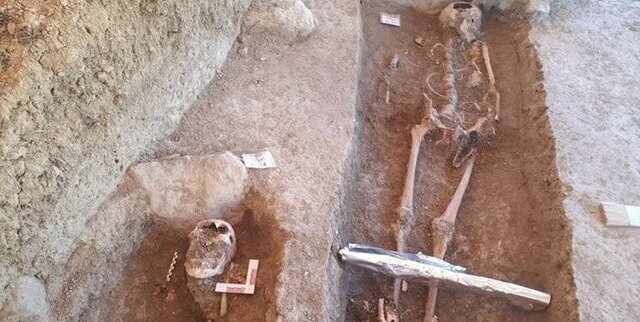Ancient graves, skeletons unearthed in north-central Iran

TEHRAN – A number of graves and human skeletons have recently been discovered by a team of archaeologists during archeological excavations at the ancient cemetery of Mersinchal, north-central Semnan province.
A total of 49 tomb chambers and human skeletons, dating back from the Iron Age to the Parthian era (247 BC – 224 CE) were discovered during a rescue season carried out at the basin of the developing dam in Mahdishahr county of the province, ISNA quoted archaeologist Mohammadreza Nemati as saying on Monday.
Researchers recognized the bone remains of 24 men, 16 women, and two children. However, the gender of seven cases remained unidentified, he added.
A wide variety of clay, silver, bronze, glass, and stone relics were also found in the graves, he mentioned.
Mersinchal cemetery has so far yielded tens of relics discovered inside the tomb chambers, as ancient people thought grave goods would be useful to the deceased in the afterlife.
The cemetery bears corps and relics from Medes, a branch of Indo-European people, who entered northeastern Iran probably as early as the 17th century BC and settled in the plateau land that came to be known as Media. And it was also used during the Achaemenid era (c. 550-330 BC).
Several potteries and personal ornamentations have so far been discovered from the cemetery, which bears over 2,000 tomb chambers.
The cemetery at Mersin is located along the southern slopes of the Alborz mountain range, east of the village of Talajim, near the Sefidrud River. The site was discovered during a rescue archaeological survey in the Fenisk Dam basin area. Based on surface materials, the cemetery was dated to the late Iron Age III and early Iron Age IV (c. 600–400 BC). To corroborate this dating, a radiocarbon date was obtained from human collagen from several graves.
As the Iron Age culture in Semnan province has not been well recognized, in August 2014, the Iranian Centre for Archaeological Research organized regular excavations at the site. Three trenches were excavated, covering a total of 235 square meters.
Within trench 3 (10×5m) fifteen human graves were found, distributed in a regular pattern. Some burials were disturbed, but common features were easy to recognize, including the rectangular shape of the grave and the presence of a single body buried in each grave, being interred in an extended position on the back. Most graves had large stones delimiting the burial place and all contained grave goods except grave 4 which was, however, disturbed.
The graves can be divided into two general categories, being either covered by large flat slabs and wood (like graves 5 and 10) or covered only by soil. There is no uniform orientation of the body within the burial. Grave goods were variable and there were, among others, pottery vessels of different types, such as single-handled pitchers, bridge spout bowls, pots with spouts and handles, small jars, pedestal bowls, and twin-joined small jars.
ABU/AM
